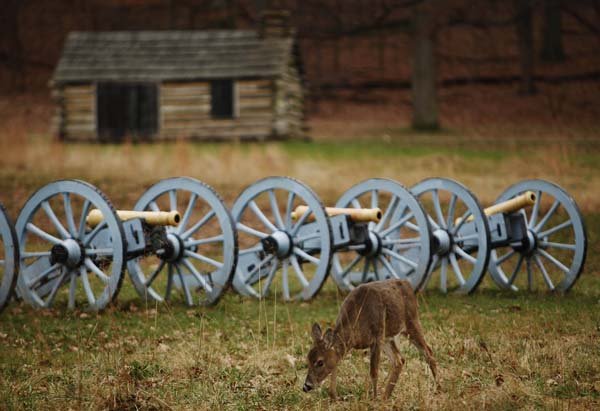VALLEY FORGE, Pa. — The National Park Service has called off its plan to deploy silencer-equipped sharpshooters this winter to cull the nearly 1,300 deer overtaking Valley Forge.
With a lawsuit pending and facing the logistics of deploying contract hunters before spring, the government decided to put off a long-planned hunt at Valley Forge National Historical Park until at least next November, Assistant U.S. Attorney Richard Bernstein said Wednesday.
Where George Washington’s tattered troops once scrambled for food and shelter, the exploding white-tailed deer population now enjoys a generous habitat of field and forest.But they eat up so many plants, officials say, they are throwing the park’s environmental balance out of whack. They are also blamed for scores of vehicle accidents within the park each year and for wreaking havoc on suburban gardens nearby.
“They cause so much damage to the environment, so many road accidents. And the roadkill - so many deer end up lying on the road. No one wants that, whether you want the deer there or not,” said Julia Urwin, 52, of Tredyffrin, who supports the hunt.
After years of heated debate and a congressional mandate to deal with the burgeoning deer colony, the park service decided this fall to cull the herd by 80 percent over four years through nighttime hunts.
Animal-welfare activists believe the park should be maintained by natural means, and filed suit to block the kill in the 3,500-acre oasis west of Philadelphia. Others doubt the plan is safe, given that homes, hotels and malls now surround the land where Washington’s Continental Army spent the winter of 1777-1778.
“The culling never works ... and I think it teaches our kids the wrong thing,” said Priscilla Cohn of Villanova, a retired philosophy professor who runs a small animal-welfare foundation. She argues that deer herds invariably bounce back after a hunt, as better-fed survivors produce more offspring and other deer move in to fill the vacuum.
“I’m a believer in science,” she said. “Shooting is from the last couple of centuries.”
Cohn’s foundation has offered about $120,000 for deer contraception and fencing to protect vegetation, but the offer is only good if no deer are slain. Park officials, she said, have ignored her.
The park management plan endorses the use of contraceptives for herd maintenance but said their effectiveness should be further studied. Meanwhile, they say the deer problem is too severe to wait.
“Our plan is linked strongly to our mission at Valley Forge ... to preserve the historic resources, the natural resources and certainly the landscape,” said park Superintendent Michael Caldwell.
Deer problems plague many parks throughout the East, and similar debates about how to shrink deer herds have played out for years. In the 1990s, Gettysburg National Military Park’s deer population was reduced by a hunt from 4,000 to just more than 200.
In Valley Forge, the posthunt target population is 175.
“This park couldn’t be better habitat for white-tailed deer. It is the perfect mix of field and forest,” said Kristina Heister, the park’s natural resource manager.
Park officials had set a Jan. 5 deadline for contractors to bid on the hunting operation, and said they needed about two months after that to initiate it. That left little time for the culling operation during the key winter months.
A lawyer for the groups involved in the suit, Connecticut based Friends of Animals and Pennsylvania-based Compassion for Animals, Respect for the Environment, said Wednesday that they are thrilled by the one-year reprieve.
“The fact that they’re not managing the parks in a natural way is really what’s driving our concern,” said Michael Harris, a University of Denver environmental law professor who represents them. “They’re supposed to be managed in a wild state.”
Harris endorses the use of coyotes - already present in the region - to thin the deer population. If that means suburbanites must learn to live with predators in their midst, so be it, he said.
That approach startles some who use the park’s 26 miles of hiking and biking path.
Front Section, Pages 4 on 12/24/2009

